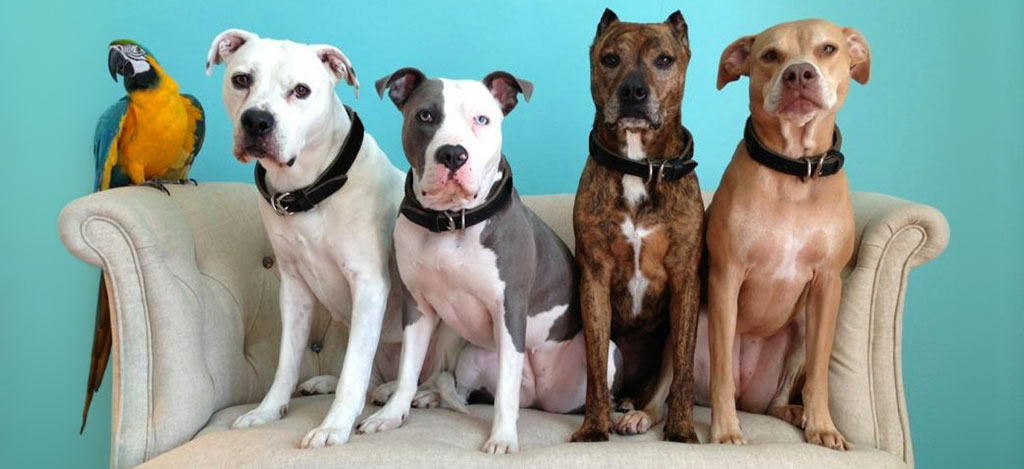
Q: What is a “Pit Bull”?
A: “Pit bull” is not actually a breed but rather a term which encompasses several breeds (American Pit Bull Terrier, American Staffordshire Terrier, Staffordshire Bull Terrier). “Pit bull” has become a slang term to describe a certain look- generally blocky head, broad shoulder, medium, muscular build. A person’s classification of what is a “pit bull” and what is not can vary from the next. So what does this mean? Not much aside from the fact that there is no such thing as a “purebred pit bull”, but these dogs are rather various breeds within one category.
Q: Are pit bulls prone to health issues?
A: On the whole and in our experience, these dogs tend to be pretty healthy overall. Pit bulls can be prone to skin issues such as allergies. We also often see knee and hip problems due to their muscular build and small legs.
Q: Are pit bulls easy to train?
A: In general, yes! Pit bull type dogs are extremely intelligent and aim to please. On the whole, they are energetic, have excellent stamina and really enjoy learning new things. They often make great agility dogs and wonderful running buddies as well!
Q: Why do pit bulls have such a bad reputation?
A: Originally pit bull type dogs were the all American family dog, even entrusted to look after families’ children. In the 1800’s, a sport developed which involved training these dogs to fight each other. Pit bull type dogs are extremely intelligent, easy to train, and aim to please their owner, so, these people found it easy to train them to engage in this grisly sport. Times changed and dog fighting because illegal, but of course, continued and this breed became popular among thugs. These circumstances continuously tarnished the image of this once “family dog” and the media exploited situations involving pit bulls as much as possible. Today, irresponsible ownership and poorly researched media coverage lead to the continued scrutiny pit bulls face.
Q: Why do we hear so much about pit bull “attacks”?
A: The media tends to bask in what they know will gain attention. When a situation involving a pit bull type dog occurs, it will be top news. Dog “attacks” and dog bites occur daily but they are often only covered when a pit bull is involved- because- this gains ratings. You’ll also notice that when a situation involving a non-pit bull occurs, the word “dog” is almost always used instead of the actual breed. Another reasons some statistics show pit bull bites as greater than other breeds is due to the fact that so many breeds fall into the “pit bull” category. Not only are the numbers in the pit bull “pool” higher than the “pool” of other breeds, other breeds are very often mislabeled as “pit bulls”.
Q: Why are there so many homeless pit bulls?
A: Irresponsible ownership, senseless breeding and lack of commitment all lead to the plague these dogs face. Even those who are not maliciously adding to the overpopulation problem can have a big impact on the issue. Spay/neuter is extremely important. Pit bulls have huge litters, often upwards or 10 or 11 puppies. Even bringing just one litter into the world means 10 or 11 shelter dogs lose the opportunity for a home. Also ensuring you are able to commit to the challenges you may face while owning a pit bull type dog is imperative to consider. Being sure you are secure in your home, financial situation, etc. can be a determination between life or death for a dog. When you re-home your dog, this also takes up a home an urgent shelter dog could have had.
Q: How significant is the overpopulation of the pit bull?
A: Only about ONE in SIX HUNDRED pit bulls finds a lifelong home. The rest are euthanized in shelters or passed from home to home until meeting the same fate, or a much worse one.
Q: Can pit bulls live with other animals?
A: Yes. Pit bulls can live with other animals, however it is important to understand that animal aggression is a normal and common trait. Some pit bull type dogs live happily with other animals for their entire lives without issue. However, because of this breed trait, it is important to follow necessary precautions. First, it is important to consider factors that add to the potential for dog aggressive behaviors. Age and gender are the two most clear-cut factors. In general, dogs of the same gender are more apt to become aggressive toward one another. So, bringing in a dog of the opposite gender is a key component. Also, pit bulls tend to pass through their “maturity” stage between ages 1 and 3. This is the time you will most commonly see temperament changes, especially related to aggression toward other animals. Staggering the ages of dogs within the home is another essential part of reducing the odds for aggression within the home. Your new dog should be introduced to resident animals very slowly. This gives everyone a chance to get to know each other and adjust. All animals should be separated when no one is home. As a rule of thumb, this ensures everyone is safe when no one is home to interject if ever needed. Many people have pit bull type dogs in multi-pet homes but it is important to be diligent and aware of possible issues and prepared to handle them should they occur.
Q: Can pit bulls live with children?
A: Yes! Dating back hundreds of years ago, pit bulls were called “nanny dogs”. This was due to their gentle, loyal and stable nature. Unfortunately, society and the media has tarnished the image of these wonderful family dogs. Pit bulls, in general, doing amazingly well with children, but as with any dog, it is extremely important to not only supervise interaction between kids and dogs, but to teach both boundaries and respect for each other.
Q: I want to get a puppy because I want to raise him/her correctly. Isn’t it “all in how you raise them”?
A: “It’s all in how you raise them” is the biggest misconception out there. It is far from the truth and can be a damaging phrase to use. With any breed, the temperament of a young puppy will change some as they age and mature. Their temperament and personality is not yet stable or developed. Many people feel that “raising a puppy the right way” is the only way to ensure you have a solid, stable dog. However, although environment and training do play a role in a dog’s temperament, so does nature. Adult dogs have developed temperaments which can be accurately evaluated. Since puppies will go through changes as they pass through maturity (with pit bulls, this generally occurs between ages 1 and 3), it is impossible to accurately evaluate their temperaments. We always encourage families with children and other animals to consider adult dogs over puppies for these reasons.
Q: Do pit bulls have “locking jaws”?
A: No. This is a myth. There have been many studies done which show pit bull skulls are the same as any other dog breed and they possess no mechanism which would allow their jaw to “lock”.
Q: Do pit bulls make good guard dogs?
A: No. Pit bull type dogs are loyal, but are friendly and gentle by nature. On the other hand, pit bulls are intelligent and easy to train. However, although they could be trained to guard, it is important to understand the damage this can do. Pit bull owners and advocates battle daily to help eradicate the negative image which has been forced upon these dogs. Training them to be “aggressive” or “scary” will only do further damage.
Are cropped ears an indication that a dog has been fought?
No. Although this is the reason ear cropping was done hundreds of years ago, it is not an indication today that a dog has been a “fighting dog”. Today, ear cropping is done by irresponsible owners to make their dog look more intimidating. It is an unfortunate practice, but it is important to understand that shelter dogs with cropped ears likely do not have a “dog fighting” background.
Q: Can pit bulls be aggressive by nature?
A: It is immensely important to understand the significant difference between “human aggression” and “dog aggression”. Human aggression is NOT a normal, common or acceptable trait for pit bull type dogs. Pit bulls are, by nature, wonderful with people. As grisly as the details are, when dog fighting was developed, pit bull type dogs were used because they are so easy to handle by humans so the handler could ensure he was never bitten. Now on the flip side, dog aggression is a normal and common trait of this breed. Some pit bull type dogs live happily with other animals without ever having any issues. But, it is important to know that dog aggression and prey drive are both normal traits and understanding the potential for these traits to develop is key to managing the situation.
